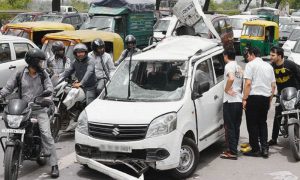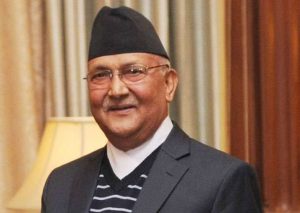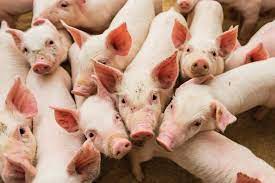Today Current Affairs: 14th May 2021 for UPSC IAS exams, State PSC exams, SSC CGL, State SSC, RRB, Railways, Banking Exam & IBPS, etc
Table of Contents
Road Accident Victims:

The Supreme Court has held that an extra 40% should be added to the income of deceased road accident victims who are aged below 40 years and are self-employed while calculating compensation.
- A three-judge Bench led by Chief Justice of India N.V. Ramana said the additional amount should be included in the income of the dead person as “future prospects”.
- The judgment is significant as it recognizes self-employment as gainful employment and calls for an increase in the compensation amount accordingly.
- Chief Justice Ramana referred to a Constitution Bench decision in National Insurance vs Pranay Sethi, which had “clearly held that in case the deceased is self-employed and below the age of 40, 40% addition would be made to their income as future prospects”.
- The High Court had earlier held the victim ineligible for future prospects because she was self-employed.
Sovereign Gold Bonds:

The Central Government in consultation with the Reserve Bank of India has decided to issue Sovereign Gold Bonds.
- The Sovereign Gold Bonds will be issued in six tranches from 17th May to September 2021.
- The Bonds will be sold through Scheduled Commercial banks (except Small Finance Banks and Payment Banks), Stock Holding Corporation of India Limited (SHCIL), designated post offices, and recognized stock exchanges viz., National Stock Exchange of India Limited and Bombay Stock Exchange Limited.
- The minimum permissible investment will be one gram of gold.
- Investors will be compensated at a fixed rate of 2.50 percent per annum payable semi-annually on the nominal value.
- The Bonds will be restricted for sale to resident individuals, Hindu Undivided Families, Trusts, Universities, and Charitable Institutions.
- The tenor of the Bond will be for a period of 8 years with an exit option after the 5th year to be exercised on the next interest payment dates.
COVISHIELD Vaccine:

The COVID Working Group chaired by Dr N K Arora has recommended extension of the gap between the first and second doses of COVISHIELD vaccine to 12-16 weeks. The present gap between the two doses of COVISHIELD vaccine is 6-8 weeks.
- Based on the available real-life evidences, particularly from UK, the COVID-19 Working Group agreed for increasing the dosing interval to 12-16 weeks between two doses of COVISHIELD vaccine.
- No change in interval of COVAXIN vaccine doses was recommended.
- The COVID Working Group is headed by Dr N K Arora- Director, INCLEN Trust.
- The recommendation of the COVID Working Group was accepted by the National Expert Group on Vaccine Administration for Covid-19 (NEGVAC), headed by Dr V K Paul, Member (Health) Niti Aayog in its meeting on 12th May 2021.
SWAMIH:

Union Minister for Finance & Corporate Affairs handed over possession to homebuyers as the Government of India’s Special Window for Affordable & Mid-Income Housing (SWAMIH) completes its first residential project.
- The residential project – Rivali Park, located in suburban Mumbai, was the first housing project in India to have received funding under the SWAMIH Fund.
- The SWAMIH Fund was launched in 2019.
- Rivali Park Wintergreens is the first investment by the Fund and is also the first project to get completed.
- In a short time span of 1.5 years since inception, the SWAMIH Investment Fund today is one of the largest private equity teams in India and has done commendable work despite COVID-19 related restrictions.
- The Fund so far has given its final approval to 72 projects that will complete 44,100 homes, while 132 projects have received preliminary approval, which will complete an additional 72,500 homes.
- Thus, the Fund is targeting to complete an aggregate of 1,16,600 homes.
- This Fund is bridging the trust deficit between homebuyers and developers by completing construction and delivering homes without depending on any other source of finance.
K P Sharma Oli :Nepal Prime Minister:

K P Sharma Oli was sworn in as the Prime Minister of Nepal for the third time. President Bidya Devi Bhandari administered his oath of office. He was re-appointed as the Prime Minister as the opposition couldn’t prove their majority
- Prime Minister K P Sharma Oli recently lost a vote of confidence in the Nepal Parliament. Now, he has to take Vote of Confidence within thirty days. If he fails to do so, Article 76 of the Constitution will be initiated.
- Article 76 of the Nepal Constitution says that the president of the country appoints the leader of the parliamentary party that gains a majority in the house as Prime Minister.
- The council of ministers is also appointed by the President under the Prime Minister.
- When no party has gained a majority in the House of Representatives, The President can appoint any Member of the House of Representatives as Prime Minister.
- He or she should be capable enough to command the majority with the support of two or more parties in the House of Representatives.
- The Prime Minister as appointed under the above procedure is given thirty days to prove his vote of confidence.
- If the Prime Minister is not able to gain the vote of confidence within thirty days, the President shall appoint the leader of the party that gained the highest number of members in the House of Representatives.
- Again he is given time to prove his majority.
- If none of the above clauses are possible, then the President shall dissolve the parliament and launch fresh elections.
Prime Minister Kisan Samman Nidhi:

Prime Minister Narendra Modi recently released the eighth instalment of Prime Minister Kisan Samman Nidhi.
- Under the Scheme, the Government of India transfers Rs 6,000 to the account of small and marginal farmers.
- These funds are transferred in three instalments. The first instalment of Rs 2,000 is made between April and June.
- The second Instalment is made between August and November. The third instalment is made between December and March.
- The scheme was begun in 2018.
- The scheme provides financial support to farmers who hold land ownership up to two hectares.
- Since its inception, the government has provided Rs 75,000 crores.
- It aims to cover 125 million farmers irrespective of their land size.
Blood Moon:

Blood Moon is to occur on May 26, 2021:
- A Blood Moon occurs when the Moon of the Earth is on a total lunar Eclipse. During this time, the moon looks red or ruddy brown. Thus it is called Blood Moon.
- The next Blood Moon is to occur on May 26, 2021. The last Blood Moon occurred on January 20-21, 2019.
- Lunar Eclipses happen only during a full moon. During this time, the moon is completely under the Earth’s shadow.
- At this time, a little bit of the sunlight that reaches the earth during sunrise and sunset falls on the moon.
- It can be noted that the sky is red in colour during sunrise and sunset.
- This means during this time out of all the seven VIBGYOR colours in the white light, only red reaches the earth.
- This red colour light is reflected on the moon and thus the moon turned into a Blood Moon.
The African Swine Fever:

The African Swine Fever has stuck Meghalaya. Earlier, it had struck Mizoram.
- The African Swine Fever has killed 1,700 pigs in Mizoram in a month. It has now spread to Meghalaya and has killed three hundred pigs here so far.
- The Philippines Government recently placed the country under a State of Calamity for a year to address the impact of African Swine Fever.
- The first case of African Swine Fever was reported in 2019.
- It has killed more than three million hogs (domesticated pigs) since its outbreak in 2019.
About African Swine Fever:
- It was first detected in Africa in the 1920s.
- There is no cure for the disease and thus the only way to stop the disease from spreading is by culling the animals.
- It is not a threat to human beings.
- This is because the disease spreads from animal to animal.
- The African Swine Fever virus is resistant to low temperatures.
- It dies only when the hogs are heated to seventy to a hundred degrees Celsius.
- It is highly contagious and is a transboundary disease.
- Between 2016 and 2019, there were 10,211 outbreaks in Europe, Asia, and Africa.
- The disease is transmitted through direct contact.
- The biological vectors that transmit the disease are ticks and fomites.
National Bamboo Mission:

The National Bamboo Mission recently launched the Management Information System to strengthen the domestic Agarbatti industry.
- It will collect data about Agarbatti production, availability of raw materials, location of stick making units, production capacity, functioning of units, etc.
- The system will act as an intermediary between the production units and the Agarbatti industry (as a whole). This will help to fill the information gaps.
National Bamboo Mission:
- The National Bamboo Mission was launched in 2018-19.
- It is currently implemented in twenty-one states.
- To boost the domestic Agarbatti units, the import duty on round sticks was increased to 25%.
- Also, the raw batti imports were moved from free to restricted category.
Beema Bamboo:
- In May 2021, the Tamil Nadu Agricultural University designed “Oxygen Park” in its premises in Coimbatore with Beema Bamboo. Beema Bamboo is a clone selected from Bambusa balcooa.
- It is a higher biomass-yielding bamboo species. Also, it is one of the fastest-growing plants.
- It grows to a height of one and a half feet in a day.
- Also, Beema Bamboo is the best carbon sink to reduce carbon dioxide in the atmosphere.
Importance of Beema Bamboo:
- They do not require replanting as it re-grows after every harvest cycle.
- They are produced through tissue culture that facilitates them to adapt to different soil and climatic conditions.
- The calorific value of Bamboo is almost equal to coal.
- Thus, cement industries have started buying this bamboo for their boilers.
Ocean Rewilding:

Ocean Rewilding is expected to come up in COP26. A network of 68 European organizations are working together to find ways to reinvigorate the marine life of the earth.
- A growing number of conservationists reject the notion that mass tree planting is a “catch-all” solution to all of our climate problems. On land, rewilding differs from reforestation in the techniques used to assess what elements are best placed, and where.
- The ocean premise is similar – reintroducing key plant and animal life into the spaces they are needed, allowing them to grow without human interference.
- Ocean rewilding is now considered to be as crucial and effective as land efforts, due to the ocean’s innate capabilities to store “blue carbon” in their seagrass meadows, tidal marshes, and mangroves.
- It is estimated that the average annual carbon sequestration rate for mangroves averages between two to four times greater than global rates observed in mature tropical forests.
- Marine populations are also served better by ocean rewilding schemes that prevent their ecosystems from devastating human interference.
- This can include protections against damaging activities such as trawling and dredging from marine sediments.
- A network of 68 pan-European organizations is constantly working together to find ways to reinvigorate our continent’s marine life.
- One composite is the BioRestore project, a French program conceived in 2012 that restocks wild coastal fish populations using elaborate scientific techniques.
- They have successfully managed to reintroduce 85 different fish species into three sites across the French Mediterranean – the next step is to lobby for their work to come under legal protection.
- Last month the UK launched its largest seagrass restoration project which will see eight hectares of seagrass planted across England’s south coast over four years.




